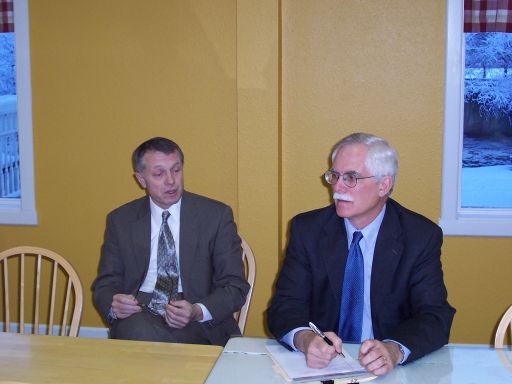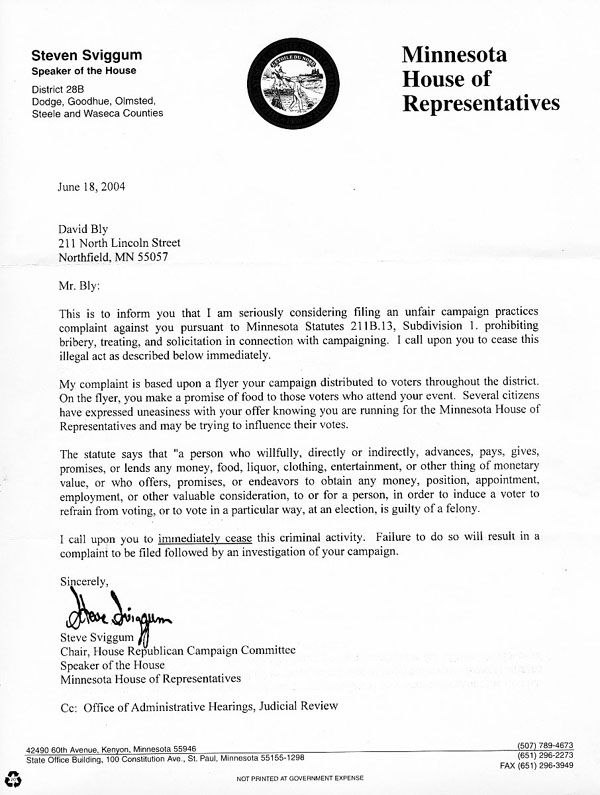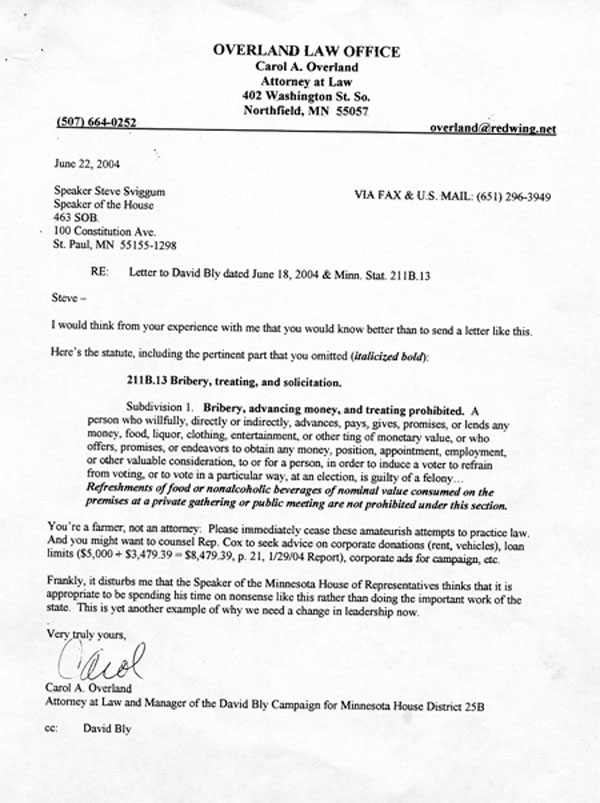Sviggum — head of Labor & Industry?!?!
June 26th, 2007

Fair Use stolen from STrib – this photo captures Sviggum’s essence!
As reported across Minnesota –
In STrib:
In St.PPP:
Associated Press on Minnesota Public Radio:
Winona Daily News:
Sviggum to leave House; date for special election uncertainÂ
Gov. Palwenty appoints Sviggum Labor and Industry Commissioner
… and from the MPR page (it may be radio, but they consistently manage to capture these guys as they are! Remember that Micheletti photo???)
Here’s the most recent Overland photo of him, from the Candidate Forum in Zumbrota just before the last election:

Last but not least, here’s Sviggum with his toady Ray Cox (stolen from Ray’s site). Steve’s the guy who as Speaker sent letters threatening felony charges for serving pie and popsicles at public events, grossly misinterpreting campaign law. Ray was a benefactor of the pie letter, but in the end, Sviggum and Cox had pie on their faces:

Looking for a demonstration of his judgment and character? Check this! Is this the kind of guy we want as Commissioner of Labor and Industry?
Cash Creek IGCC under scrutiny
June 26th, 2007

Coal plant proposal of the day: Cash Creek
Another proposed coal gasification plant is under scrutiny. The Cash Creek IGCC plant is the subject of a public hearing later this week. If it receives reasonable public scrutiny, if the emissions information is public, how could it receive anything but a loud DENIAL of the permit? It’s happened in Minnesota and Delaware, IGCC plants have been found to be not what the proposers spin would indicate. Georgia turned down an IGCC plant recently too. It’s time for another to go down…
PUBLIC HEARING
CASH CREEK AIR PERMIT
Friday, June 29, 2007 @ 6:30 p.m.
Henderson County Courthouse
20 North Main Street
Henderson, KY
Phone: (270) 826-3971
————————————————
Here’s the Draft Air Permit, thanks to Valley Watch:
————————————————-
So I called the Kentycky Air Permit Division, and because Jim Morse, the contact listed on the Cash Creek page (502-573-3382) was on the phone, and so was transferred around several times trying to get information on the deadline for written comments and the process for submission.  Finally I got someone who said that yes, Comments could be submitted by mail and email, and to go to the Notice page, which he directed me to. OK, fine, so the Notice says Comments may be submitted for 30 days after the publication of the Notice, by mail they must be postmarked by that date. What’s the date of the Notice? MAY 20, 2007!!!!
 The Comment period ended June 19 or 20, 2007, depending on how you count. So I called back, got Jim Morse (502-573-3382) and asked about that, and he didn’t regard that as a problem. “So what would you like me to do about that?” I said that the Comment period should be extended to provide for submission of Comments some time after the public hearing. He offered some lame nonsense about being bound by regulations, and I said that I doubt the regulations expressly limit extension of that deadline. “And who am I talking to?” I told him and told him of our experience with Mesaba and that I’m working on getting the air emissions information out to the world, to other jurisdictions where IGCC plants are being considered, because the MPCA analysis and the MN record demonstrated that IGCC is NOT what it’s cracked up to be. He said I should take it up with the Director of the Division, who has already denied two requests for extensions! Yup, this is how it goes in Kentucky. He said I should find someone who will be there to submit comments. OK, fine, I will…
 ————————————-
 Check out this article, and register your comments — registration at the site is a bit of a pain, but it’s worth it to weigh in on this project:
By Mark Wilson (Contact)
Monday, June 25, 2007With the region facing the challenge of soon having to meet tougher air pollution regulations, environmentalists and local officials are concerned about the impact the proposed Cash Creek power plant in Henderson County, Ky., could have on air quality in the Evansville area.
They’re expected to raise those concerns at a public hearing on the Cash Creek air pollution permit at 6:30 p.m. Friday at the Henderson County Courthouse.
The area learned last week that the U.S. Environmental Protection Agency is proposing tighter standards on ozone pollution which many counties, including Vanderburgh and Warrick, may have difficulty meeting when they take effect in 2008. In addition, both counties already do not meet federal standards for fine particulate pollution.
“On behalf of the City of Evansville, I would like to reiterate my concerns about the negative impacts a new power plant would have on our region’s air quality,” wrote Mayor Jonathan Weinzapfel in a three-page letter to the Kentucky Division of Air Quality on June 18.
Warrick County Commissioners and Newburgh also have filed letters of concern about the power plant’s possible impact on air quality.
A representative of the Erora Group, the Louisville, Ky.-based company developing the Henderson County power plant, said Friday the facility’s use of “clean coal” technology will cause it to have little impact on local air quality. Building and operating the power plant, they say, will be a boon to the economy.
Despite those assurances, Weinzapfel has asked Kentucky environmental officials to take extra steps to require strict pollution controls and reduction strategies.
The latter includes conducting pollution monitoring both before and after building pollution sources and conducting modeling that would examine the impact of plants such as Cash Creek on air quality in Vanderburgh and Warrick counties.
The plant would be located on Kentucky 1078 near the Green River and next to Patriot Coal Co., which is expected to provide most of the Western Kentucky coal that developers are pledging to use for fueling the plant.
The estimated building cost, $1.5 billion, will create more than 1,000 construction jobs. The plant would employ an estimated 200 people when in operation.
“We are always looking for jobs,” said Paul Kuerzi, board chairman for the Henderson County Chamber of Commerce. “Yes, we are concerned about the environment, but our take is this appears to be as clean a project as you could have in this particular industry. The technology they will be using is quite advanced.”
Cash Creek would use a still-fledgling process called IGCC (integrated gasification combined cycle) that would convert coal into a synthetic gas of mostly hydrogen and carbon monoxide that would then be burned to power turbines and create electricity. The plant is expected to produce 630 megawatts of power for sale.
“We believe it will be the cleanest plant, certainly in Kentucky, if not in the country,” said David Schwartz, an Erora Group spokesman.
Although Cash Creek would have pollution controls for both particulate pollution and ozone-causing nitrogen oxide pollution, according to its proposed permit, it would still have the potential to generate more than 700 tons a year of nitrogen oxide pollution and other pollutants.
“Clean technologies not withstanding, Cash Creek would emit hundreds of tons of air pollution each year and may negatively impact our air quality,” Weinzapfel wrote.
John Blair, president of Evansville-based environmental group Valley Watch, said he will argue at Friday’s hearing that Kentucky officials should treat the plant as if it were going to be located in an area of non-attainment for air quality standards.
“This plant should be built with offsets (equivalent reductions in pollution) as if it were in a non-attainment area,” he said.
“This plant will have an impact on Vanderburgh and Warrick counties, particularity Warrick.”
Don’t breathe today or tomorrow!
June 25th, 2007
The St. Paul “hazecam”this a.m.
The STrib reports that it’s not a good time for those of us who breathe:
Take note today, as hot air and humidity combine for pollution health advisory
It’s ozone and PM 2.5 — an obvious demonstration of why we don’t need to be building any more coal plants, incinerators, and other combustors anytime soon. Or exempting them from emissions laws… or relaxing Waste Combustor regulations… or exempting “biomass” from regulation (if it’s so “clean” why would it need exemption, eh?).
Specifics for:
The Baltimore “hazecam” (there isn’t one for Delaware, but it’s raining, dreary…)Â
Mulling over Rock-Tenn incinerator
June 20th, 2007
Last night the Neighbors Against the Burner held a meeting at Macalaster, featuring none other than Alan Muller! And no, I didn’t have anything to do with it, they found him independently, serendipitous, eh?
There have been several reports written about the proposal for Rock-Tenn and Minnesota incineration issues that are worth reading.
What Ramsey and Washington Counties want to do:
Foth report for Ramsey County on RDF/”Biomass” incinerator at Rock-Tenn
A Green Institute Report that had a very limited and limiting scope (a $50,000 make-work grant to show that something cleaner than garbage just isn’t possible???) :
The MPCA has posted its annual air quality report:
Alan learned from the MPCA website that the MPCA Waste Combustor rules DO NOT MEET THE FEDERAL STANDARDS and must be updated. They “started” this a coon’s age ago yet it’s not even reached the SONAR stage… seems it’s not exactly a high priority. Why?
Be sure to check out the Neighbors Against the Burner site:
Here’s the article from today’s St.PPP:
St. Paul / Neighbors oppose incinerator plan
Rock-Tenn wants to burn garbage for fuelBY JASON HOPPIN
Pioneer PressAn opposition movement came to Macalester College’s Kagin Commons Tuesday night.
More than 125 neighbors attended a meeting by a group opposed to burning fuel derived from household garbage at a proposed Midway power plant. They filtered in from neighborhoods that have grown up around Rock-Tenn, the 99-year-old St. Paul paper recycling facility at the core of the controversy.
The neighbors say they’re concerned about the future, as are many who are following the Rock-Tenn story.
The plant is losing its source of cheap steam energy, a byproduct of the conversion of Xcel Energy’s coal-powered High Bridge plant to natural gas. Local officials are worried that Rock-Tenn may close – resulting in the loss of 500 high-paying jobs there.
Several parties are exploring whether to build an on-site power plant to provide Rock-Tenn a new, affordable source of energy. But one alternative for that proposed plant – using “refuse-derived fuel,” or RDF, to help power it – is generating opposition among many neighbors.
“We will not allow an incinerator to be (built) in St. Paul,” said Nancy Hone, who started Neighbors Against the Burner through meetings held in her living room. “This is insane.”
At first the group was small, but it appears to be growing in scale and sophistication. On Tuesday, members handed out buttons, T-shirts and lawn signs – a holy trinity for grassroots organizations.
The group also flew in Alan Muller, who heads Green Delaware, an environmental advocacy group, to argue that burning any biomass – whether it’s garbage or any of several alternatives being explored for the site, including farmed native grasses or construction waste – is dangerous to people’s health.
“The only way to protect your health from a burner is to just say ‘no’ to it,” said Muller, who drew from a 2005 study published by a group of British doctors for most of the conclusions during his PowerPoint presentation.
Supporters say harmful emissions can be filtered out and that the Minnesota Pollution Control Agency would have to sign off on the plant. A handful of similar power plants currently are in operation throughout the state.
Neighbors Against the Burner’s growth could make building the power plant politically difficult. The group was formed partly out of dissatisfaction that a second neighborhood group – which drew a similarly sized crowd during its first public meeting – was not taking a strong enough stand against refuse-derived fuel.
That group, called Rock-Tenn Interested Neighbors, is being run in collaboration with neighborhood district councils and has made no conclusions about what kind of materials should be used to fire the plant.
The second group will also serve as a neighborhood voice on a state-funded, $4.5 million feasibility study on the plant soon to get under way. But with the rise of Neighbors Against the Burner, there is the possibility that, at the very least, mixed messages will be sent about the wishes of Rock-Tenn’s neighbors.
Officials connected to the power plant efforts have said they would prefer the plant be able to burn a variety of fuel sources. But some have acknowledged that to make the project work financially, RDF would have to be used.
The project is being headed by the St. Paul Port Authority, which would own the plant. It would be operated by District Energy, which burns wood waste and coal at its downtown plant to provide heating and cooling to much of the downtown area.
Jason Hoppin can be reached at jhoppin@pioneerpress.com or 651-292-1892.
Kenyon Wind at PUC
June 17th, 2007

More in the Beagle – an article about Kenyon Wind. One thing, of several, that concerns me about this project are some facts that are being ignored:
Steve Sviggum was Speaker of the House in 2005.
In 2005, the House Republicans gave unprecedented support to the Omnibus Energy Bill.
The 2005 Omnibus Energy Bill created C-BED, a legislative change in the permitting and financing of wind projects.
The first C-BED project out of the chute is Kenyon Wind.
Kenyon Wind was certified as a C-BED project by Commerce’s Mike Bull.
CFERS requested the underlying documentation of the organization structure of Kenyon Wind that revealed ownership.
Commerce’s Mike Bull stated that he had the organizational documentation, certified it as a C-BED project, and did not keep the documentation.Â
Kenyon Wind is a group long-time wind activists developing their first wind project.
Steve Sviggum is the primary party of the trust that owns the land that Kenyon Wind’s turbine 6 and the collector substation sit on.
Steve Sviggum’s interest and the trust’s lease and/or ownership interest in Turbine 6 and the collector substation has not been disclosed.
The ownership of turbine 6 has not been disclosed.Â
Just the fact that the former speaker is doing business with long-time wind advocates who have never built a wind project before is enough to put red flags up… Steve Sviggum knows House ethics standards well — he testified about it at former Rep. Loren Jennings’ felony trial. Loren Jennings is now in the hoosegow.
Loren Jennings – Appellate Court Opinion citing Sviggum’s Testimony
When did Sviggum first have a financial interest in C-BED?
Has Rep. Sviggum disclosed his interest in C-BED when it comes up for a vote???
Jen Cullen
The Republican Eagle – 06/15/2007ST. PAUL — The Syverson family’s vision of their Kenyon Township farm never involved giant wind machines.
Now — against their wishes — it does.
The Minnesota Public Utilities Commission on Thursday approved a permit allowing construction of a nine-turbine wind farm just outside of Kenyon.
“There are other alternatives,” landowner Selmer Syverson said after the commission’s decision. “This is bad, but I’ll have to put up with it.”
A small group of private investors dubbed Kenyon Wind LLC is behind the more than $20 million project.
Xcel Energy will purchase electricity from the 18.9-megawatt commercial-size farm.
The turbines, which tower 406 feet into the air, will be placed on land leased from property owners in Kenyon and Cherry Grove townships.
Syverson and his son, Steve, joined other members of Citizens for Environmental Rights and Safety at the meeting.
The recently formed grass-roots group still has major environmental and safety concerns, among other issues, with the project.
Red Wing attorney Carol Overland asked commissioners Thursday to take a closer look at those concerns. Commissioners changed nothing in the final permit, despite Overland’s attempts.
“We are probably not able to address the issues to the satisfaction of everyone in the area who has a concern,” said PUC Chairman LeRoy Koppendrayer. “We do the best we can.”
Discussing tactics with her clients after the meeting, Overland said the group could take its case to the Minnesota Court of Appeals or formally ask the state to reconsider Thursday’s decision.
Mike Chase, president of the local citizens group, said Thursday’s outcome will not stop them from scrutinizing the wind farm project.
“We expect to be very active in this project as it moves on — very vigilant, very involved,” Chase said. “I’m disappointed that in spite of all the valid concerns raised they weren’t fully investigated.”
John Daniels Jr., chief manager of Kenyon Wind LLC, said Overland’s game plan Thursday was about throwing up roadblocks instead of addressing valid concerns.
Daniels said issues raised Thursday had already been dealt with.
“This discussion is really obstructionist,” Daniels told the commission. “It’s not really helpful.”
Issues remain
Overland and her clients aren’t buying Daniels’ claims.
They continue to be unsatisfied with how the permit addresses the following:
• Safety — Are the turbines the best model? What happens if they were to fall down or be struck by lightning?
• Setbacks — Overland said the 250-foot setback from nearby roads needs to be moved back to at least 500 feet.
• Environmental issues — Protection of wetlands, farmland and wildlife in the area is a big concern to Overland and her clients. Overland claimed Thursday that the rotors of the turbines impede on wetlands, which goes against DNR suggestions, she said.
• Decommissioning of the wind farm — Money to take down the project won’t be saved right away. Overland argues that’s not the best way to do business.
• Ownership of the project — Overland has filed requests for information on who specifically owns the wind farm project. She said simply labeling the company as Kenyon Wind LLC isn’t transparent enough.
“We want to know what the underlying ownership structure is,” Overland said. “They present it as Kenyon Wind. We don’t know who that is.”
Daniels said he and his partners haven’t kept any secrets on their identity. Only four people have been publicly named as partners: Daniels, his wife and two others. It is unclear if there are more.
“We’re not a secret organization,” Daniels said. “We’re out in the public.”
Chase said he and other members of the citizens group who attended Thursday’s meeting are still miffed at what they consider a lack of public discussion regarding the wind farm.
While they aren’t against wind energy, most landowners in the area don’t agree with the way the Kenyon project has panned out, Chase said.
Chase’s ultimate goal would be to have the wind farm axed completely or for the public to have input on turbine location.
“We believe the turbines didn’t belong in this location,” he said. “This is, above all, about the environment.”
Steve Syverson, whose father owns 80 acres in the affected area, still gets fired up when wind farm discussion surfaces. He will inherit his father’s land someday. Property littered with turbines, he said, doesn’t appeal to him.
Or anyone else, he feels.
“Respect people’s rights,” Syverson said. “Go somewhere less populated.”



